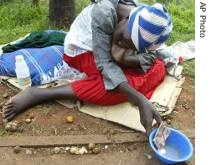2007年VOA标准英语-Zimbabwe Inflation Leaps to Hyper Level(在线收听)
Harare
13 May 2007
Prices of consumer goods, particularly groceries, have doubled in a month in Zimbabwe. Peta Thornycroft reports for VOA that Zimbabwe shopkeepers and consumers are shock at the sudden leap in prices of food saying that the rate of inflation, already the highest in the world, is now leaping ahead so fast that no one can predict the consequences.

A woman begs in a street in Harare, Zimbabwe (File)
A housewife shopping at a Harare supermarket Saturday said the price of the staple food maize meal was now 22 times higher than it was in December, a product still subsidized by the government.
The controlled price of bread, she said, was ten times higher than three months ago.
She said one small shopping bag of essential goods on Saturday had cost her nearly one million Zimbabwe dollars, or $33 U.S. on the black market, or $4,000 U.S. at the official rate of exchange.
Officially Zimbabwe's inflation is 2,200 percent. That number comes from the government's Central Statistical office in Harare.
The International Monetary Fund this month said that Zimbabwe reached the hyper inflation rate in the month of March. Economists define hyper inflation as growth in inflation of over 50 percent month on month. Though official inflation numbers for April have not been officially released, some economists say there was a 160 percent gain on the month leading to a 6,300 percent increase on the year, far above the IMF prediction of 5,000 percent for 2007.
The official rate of inflation, according to international accountants in Harare, is far lower than the real rate. That is because the Central Statistical Office calculates some essential goods according to official prices, and not street prices.
The four main supermarket chains in Zimbabwe, which keep their own statistics for their range of groceries and food say that the rate of inflation is presently around 11,000 percent.
Economist John Robertson said the official rate of inflation for April would probably be about 3,000 percent for all goods and services but he anticipates the real figure could be twice that amount.
When inflation hits that figure shortly of 6,000 percent per year, Robertson anticipates prices could double weekly.
He said retailers are unsure of how much to mark up their goods because they can no longer anticipate what new prices from wholesalers will be.
He said inflation could soon reach the point where Zimbabweans no longer trust their own currency, and when that happens, he says, they might seek to trade in foreign money.
Making sense of the value of Zimbabwe dollar is difficult as there are two rates of exchange. Most calculations are done by using the black market rate which is based on demand for those with access to foreign money.
It is more than 100 times higher the official rate of exchange. Most consumer goods are calculated using the black market rate of exchange, which is 25,000 Zimbabwe dollar to one U.S. dollar.
Most Zimbabweans have no access to foreign currency and so the present prices of basic essentials in Zimbabwe dollars are beyond the reach of the majority of people.